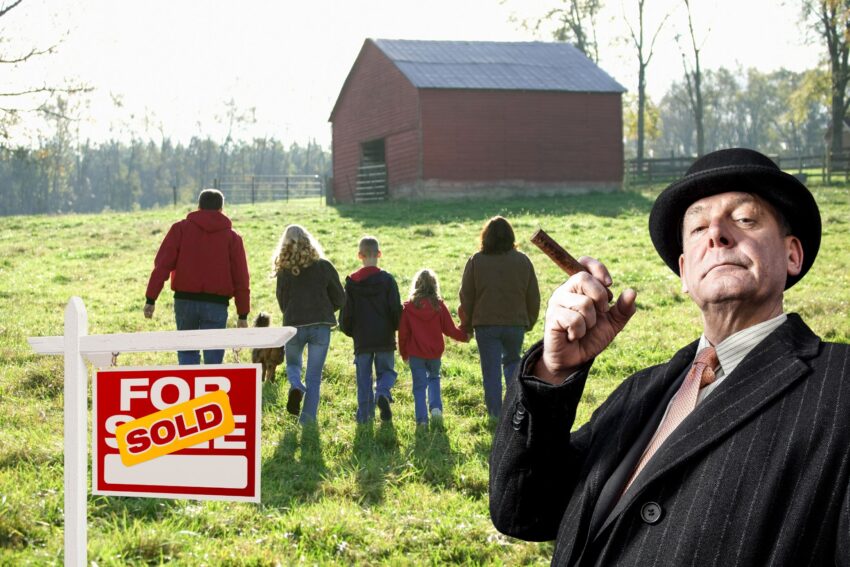The landscape of American agriculture is undergoing a transformation, and not for the better, at least not for the family farmer. Over recent decades, the number of family farms has dwindled, overshadowed by the rise of agribusiness giants and the strategic acquisition of farmland by entities both domestic and foreign. This shift poses significant challenges to the cultural fabric, economic stability, and food security of the United States.
Recent agricultural census data paint a stark picture: the U.S. lost over 141,000 farms between 2017 and 2022, with more than 20 million acres of farmland disappearing from the country. 75 million acres were lost over the past 25 years. This decline isn’t just about numbers; it’s about the heart of rural America fading away. Why is this happening?
In the last five years, America has lost more than 140,000 family farms. Failure to pass a new #FarmBill that strengthens the farm safety net would further exacerbate the crisis our rural communities are facing. https://t.co/eGM0kRUMul
— House Committee on Agriculture (@HouseAgGOP) September 24, 2024
The most common explanation for the loss of both family farms and farmland is that farming has become more efficient, with larger yields on less lands. This does indeed explain part of what’s happening, but it is certainly not the whole story. More and more, we are seeing small farms make way for massive agribusinesses.
Democrats are counting Bankruptcies, but they purposely omit to say how many farms went out of business instead. Over 140,000 Farms Lost in 5 years… pic.twitter.com/qL67zlTDMD
— Captain Flint (@Captain_Flint_T) September 24, 2024
Much like how Amazon and Walmart have transformed retail, agribusinesses have changed agriculture. These giants operate on economies of scale that family farms can’t match. They benefit from:
- Lower Costs: Bulk buying, advanced technology, and efficient distribution networks reduce costs, making it hard for small farms to compete on price.
- Cheap labor: One of the way these businesses keep their costs low is by employing migrant laborers, who are often working in America illegally.
- Access to Markets: Large agribusinesses have direct lines to global markets, often inaccessible to smaller operations.
- Government Subsidies: While designed to help all farmers, these subsidies often disproportionately benefit larger operations due to the scale of their production.
This competitive edge forces many family farms into a corner, either to sell out or scale down, further reducing their viability.
US Farmland Declines by 75 Million Acres Over 25 Years, Census Data Shows #Censusdata #U.S.Census #Landuse #Agriculturehttps://t.co/w15P7Dnoe3 Chinese bought it
— Steve Burgess (@sandals101) September 24, 2024
A particularly concerning trend is the acquisition of American farmland by foreign entities and wealthy individuals like Bill Gates. Foreign ownership, especially by countries like China, should be viewed through a lens of national security. Food production is not just an economic activity but a strategic asset. Control over U.S. farmland could influence food security and policy. Additionally, when land is bought by large investors or foreign entities, it often leads to the displacement of local farming communities. Wealthy individuals, corporations, and governments buying up vast tracts of land further concentrate wealth and control, potentially leading to a monopoly on food production.
The decline of family farms isn’t just economic; it’s cultural and environmental. Family farms are stewards of tradition, land stewardship, and community resilience. Their disappearance erodes rural culture and community structures. Small family farms often practice more diverse and environmentally friendly farming methods. Family farms reinvest in local economies. Their decline means less economic activity in rural areas, leading to job losses and community decay. Massive agribusinesses do not serve the same community interests that a family farm does. Also, the shift towards industrial agriculture can lead to monocultures, which are more susceptible to pests, diseases, and environmental degradation. A landscape dominated by a few large players could jeopardize food security. A larger number of farming operations ensures stability against market fluctuations or natural disasters.
To counteract these trends, policies must be revisited and reformed. We need to enhance access to subsidies, markets, and technology for small operations. We need to continue implementing checks on foreign land acquisitions, perhaps through a strategic land reserve or more transparent ownership regulations, which is currently in the works in DC. Finally, we need programs to help the next generation of farmers or transition current owners into new roles or cooperative farming models.
The decline of family farms isn’t just about losing farms; it’s about losing a way of life, community, and a varied, resilient food system. Protecting these farms is protecting the soul of America’s rural heartland.
"There were 8% fewer acres of land in U.S. farms in 2022 than in 1997… Pastureland had the largest percent loss, at 13%"
(https://t.co/xImt9AZ7PK) #collapse
— Collapse Aphorisms (@CollapseDiaries) September 19, 2024


